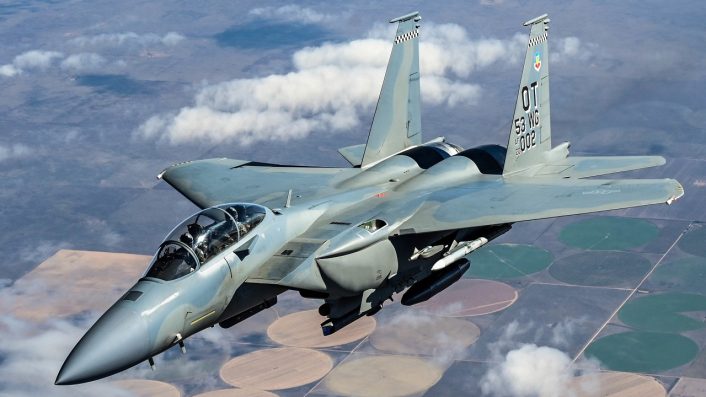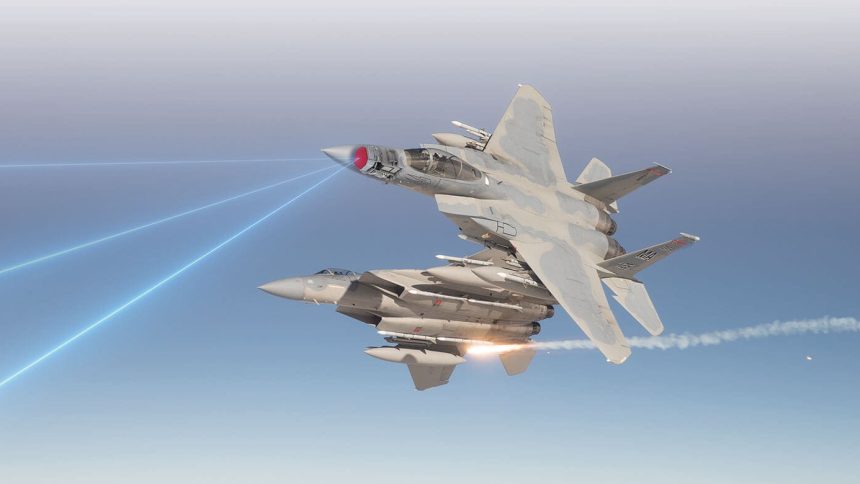The latest iteration of the combat-proven APG-82 radar incorporates gallium nitride (GaN) technology to enhance the radar’s effectiveness and capabilities.
Raytheon has unveiled a major upgrade to the APG-82 Active Electronically Scanned Array (AESA) radar, called the APG-82(V)X. The new radar integrates gallium nitride (GaN) transmit/receive technology to deliver increased range, higher processing speed and enhanced electronic-warfare functionality.
The company says in its press release the new variant is intended to give aircrews a “first-look, first-shoot advantage” against evolving threats such as cruise missiles, swarms of small unmanned aerial systems and modern fighters. The use of the GaN technology ensures the radar can deliver the new capabilities without needing additional power.
GaN-powered performance boost
According to RTX, Raytheon’s parent company, the APG-82(V)X leverages thousands of transmit/receive modules and an open-architecture processor to switch rapidly between air-to-air, air-to-ground, and electronic-warfare modes. RTX further highlights that these characteristics enable faster target detection, tracking, and engagement across multiple mission profiles, giving aircrews a decisive edge in high-threat environments.
📰NEWS: Raytheon unveils its new APG-82(V)X radar enhanced with gallium nitride.
Details: https://t.co/A3ioL1NX9P pic.twitter.com/OsqRf9dbZ6
— RTX (@RTX_News) September 23, 2025
“The enhanced capability of this next-generation radar enables aircrew to detect and engage threats at longer ranges than ever before, providing a crucial first-look, first-shoot advantage,” said Dan Theisen, president of Advanced Products and Solutions at Raytheon. “As the threat environment evolves, this new radar will ensure faster decision making and superior situational awareness in contested environments.”
GaN technology is said to provide greater power efficiency and thermal tolerance than gallium arsenide (GaAs), which is considered as the standard baseline material for T/R modules. The improved properties of GaN translate into longer detection ranges, wider frequency agility, and improved resilience against jamming.
Development of the radar is underway in El Segundo, California, says the company, with production planned on mature lines in Forest, Mississippi. RTX notes the system is scalable and designed to open-architecture standards, ensuring adaptability for both current and future-generation platforms.

From the APG-82(V)1 to the APG-82(V)X
The new radar builds on the APG-82(V)1, which was developed to replace the mechanically scanned APG-70 radar on the F-15E Strike Eagle. Introduced as part of a Radar Modernization Program (RMP), the APG-82 (V)1 combined technology from two of Raytheon’s most successful AESAs: the APG-63(V)3, used in upgraded F-15C/D Eagles, and the APG-79, fielded on the F/A-18E/F Super Hornet.
The APG-82(V)1 brought the Strike Eagle into the AESA era, delivering simultaneous air-to-air and air-to-ground functionality that allowed pilots to detect, identify, and track multiple airborne and surface targets at extended ranges compared to older mechanically scanned radars. Key to its effectiveness was the radar’s ability to maintain persistent surveillance of several targets while sharing information in real time with other platforms.
The AESA’s solid-state transmit/receive modules significantly improved reliability and reduced maintenance demands, addressing one of the persistent challenges of mechanically steered systems. The upgrade gave the F-15E enhanced lethality and survivability in contested environments, providing crews with the ability to engage threats quickly while also supporting strike missions with high-resolution ground mapping.
The APG-82(V)1 can be considered to have established the baseline architecture that the new APG-82(V)X now takes further with GaN technology, faster processors, and greater scalability.
RTX calls the APG-82(V)X a significant force multiplier, saying it can seamlessly integrate with other sensors and platforms, or ground-based systems, creating a comprehensive picture of the battlefield, increasing aircrew and friendly force awareness and give troops the data they need to make informed decisions.









